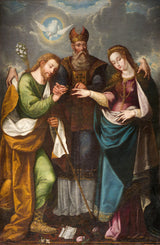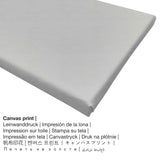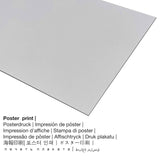Pedro Ramírez, 1668 - Le mariage de la Vierge (Desposorios del la Virgen) - tirage d'art
TTC Expédition calculée à la caisse.
Spécifications détaillées du produit
Cette œuvre d'art vieille de plus de 350 ans The Marriage of the Virgin (Desposorios del la Virgen) a été réalisé par l'artiste Pedro Ramirez in 1668L’ 350 une œuvre d'art âgée de plusieurs années mesure la taille 75 5/8 × 50 3/8 pouces (192,09 × 127,95 cm) et a été fait avec la techinque de oil on canvas on wood panel. En outre, les œuvres d'art peuvent être vues dans la collection d'art numérique de Musée d'art du comté de Los Angeles. With courtesy of: Los Angeles County Museum of Art (www.lacma.org) (public domain license).Creditline of the artwork: . The alignment is in portrait format with an aspect ratio of 2: 3, ce qui implique que la longueur est 33% plus courte que la largeur.
Choix de matériaux disponibles
Pour chaque tirage d'art, nous proposons une gamme de matériaux et de tailles différents. Nous vous permettons de choisir parmi les variantes suivantes:
- Dibond en aluminium: An Aluminium Dibond print is a material with an outstanding depth. A non-reflective surface creates a contemporary impression. The Aluminium Dibond Print is the excellent start to fine replicas with aluminum. Colors are luminous and vivid in the highest definition, the details of the print are clear and crisp.
- Affiche imprimée sur toile: A poster is a UV printed flat cotton canvas paper with a slight structure on the surface, that reminds the original masterpiece. Please note, that depending on the size of the poster print we add a white margin of something between 2-6cm round about the painting, which facilitates the framing.
- Impression sur toile: A printed canvas material applied on a wooden frame. A canvas creates a particular impression of three-dimensionality. Hanging a canvas print: A canvas print has the advantage of being relatively low in weight, which implies that it is easy to hang up your Canvas print without additional wall-mounts. That is why, a canvas print is suited for all types of walls.
- L'impression sur verre acrylique: A glossy acrylic glass print, often referred to as a print on plexiglass, will change your favorite original artwork into gorgeous décor. With an acrylic glass fine art print sharp contrasts as well as minor artwork details will be exposed with the help of the precise tonal gradation. Our real glass coating protects your chosen fine art print against light and heat for between four and six decades.
Legal note: We try our utmost to depict our products as exact as possible and to demonstrate them visually on the various product detail pages. Still, the pigments of the printing material and the printing may vary somehwat from the image on the monitor. Depending on your settings of your screen and the quality of the surface, not all colors are printed as exactly as the digital version shown here. Bearing in mind that all the art reproductions are processed and printed by hand, there might as well be slight deviations in the exact position and the size of the motif.
Informations générales sur l'article
| Type de produit d'impression: | tirage d'art |
| Méthode de reproduction: | reproduction numérique |
| Processus de fabrication: | impression numérique (impression directe UV) |
| Origine du produit: | fabriqué en Allemagne |
| Type de stock: | production à la demande |
| Utilisation prévue du produit: | décoration murale, galerie de reproduction d'art |
| Orientation de l'oeuvre: | alignement portrait |
| Rapport d'image: | 2: 3 - longueur Largeur |
| Interprétation du rapport d'image: | la longueur est 33% plus courte que la largeur |
| Choix de tissus: | impression sur verre acrylique (avec revêtement en verre véritable), impression d'affiche (papier de toile), impression en métal (aluminium dibond), impression sur toile |
| Options de taille de toile sur châssis de civière (impression sur toile): | 20x30cm - 8x12 ", 40x60cm - 16x24", 60x90cm - 24x35 ", 80x120cm - 31x47" |
| Impression sur verre acrylique (avec revêtement en verre véritable): | 20x30cm - 8x12 ", 40x60cm - 16x24", 60x90cm - 24x35 ", 80x120cm - 31x47" |
| Variantes de taille d'impression d'affiche (papier de toile): | 40x60cm - 16x24 ", 60x90cm - 24x35", 80x120cm - 31x47 " |
| Options d'impression dibond en aluminium: | 20x30cm - 8x12 ", 40x60cm - 16x24", 60x90cm - 24x35 ", 80x120cm - 31x47" |
| Cadre photo: | veuillez noter que cette impression d'art n'a pas de cadre |
Détails sur l'œuvre d'art originale
| Titre de l'œuvre: | "The Marriage of the Virgin (Desposorios del la Virgen)" |
| Catégorisation de l'oeuvre: | peinture |
| Terme général: | art classique |
| Classification temporelle: | 17th siècle |
| Année de l'oeuvre: | 1668 |
| Âge de l'oeuvre: | plus de 350 ans |
| Support d'illustration originale: | oil on canvas on wood panel |
| Taille de l'oeuvre originale: | 75 5/8 × 50 3/8 pouces (192,09 × 127,95 cm) |
| Musée: | Musée d'art du comté de Los Angeles |
| Lieu du musée: | Los Angeles, Californie, Etats-Unis d'Amérique |
| Site Web du musée: | Musée d'art du comté de Los Angeles |
| Licence d'oeuvre d'art: | domaine public |
| Avec l'aimable autorisation de: | Musée d'art du comté de Los Angeles (www.lacma.org) |
Information structurée sur l'artiste
| Nom de l'artiste: | Pedro Ramirez |
| Sexe de l'artiste: | mâle |
| Travaux de l'artiste: | peintre |
| Catégorie d'artiste: | vieux maitre |
© Droits d'auteur | Artprinta (www.artprinta.com)
Spécifications des œuvres d'art originales du musée (© Copyright - Musée d'art du comté de Los Angeles - Musée d'art du comté de Los Angeles)
Notes from the Curator: Pedro Ramírez descended from a prominent family of sculptors and altarpiece-makers. His father, Pedro Ramírez El Viejo (d. 1679), was born in Seville and immigrated to Mexico City where he achieved great success, as attested by the wealth he amassed at time of his death. Pedro Ramírez El Mozo (1638–1679), was already born in Mexico City. Regretfully we do not know much about his early training, which possibly took place either in Mexico City or Puebla, where he married and settled for some time before returning to the viceregal capital. His work is characterized by stark contours, firm modeling and a high degree of naturalism. One of his most characteristic traits is his brilliant handling of light and shade, which impart his compositions with a sense of depth and theatricality.
The subject of the Marriage of the Virgin is based on apocryphal accounts of the event in the Golden Legend, a thirteenth-century collection of the lives of saints by Jacobus de Voragine. Though the subject was represented in Europe (e.g., Durer and Raphael), on the whole it was rare in Spanish Golden Age painting (one notable exception is Francisco Pacheco's scene of 1588 for the Iglesia de la Anunciación in Seville). Curiously, the subject seems to have gained more currency in New Spain where it was taken up by some of the best brushes of the time: José Juárez (c. 1585–1639); Luis Juárez (c. 1586–1639), and Sebastián López de Arteaga (1610–1652), the latter whom came to Mexico from Seville in 1640. In the early eighteenth century, the famous Cristóbal de Villalpando also rendered his own version.
The simple composition depicts the Jewish high priest in the center, flanked on either side by the holy couple. Joseph holds the flowering staff to symbolize that he was chosen by God to marry the Virgin. Among the most striking details are the priest's hands, with every knuckle clearly drawn, as well as the realism of his facial expression. The scene is presided over by the Holy Ghost, beautifully rendered within a circle of light, as two majestic hands descend from the heavens to embrace the couple and sanctify the union. This inclusion of God's hands is an unusual detail that recurs in the works of all the New Spanish painters mentioned above, but which is conspicuously absent from the Europeans models. It is possible that the artists shared a common visual source (either a print or a painting that is yet to be identified), but it is even more likely that they were looking at each other's work, demonstrating the significance of a local tradition of painting within Mexico itself. While several works by Ramírez have been identified throughout Mexico (including in Mexico City's cathedral), this is a remarkable example from the artist's small surviving oeuvre.
Ilona Katzew, 2010
Notes from the Contributor: Painting by Pedro Ramírez (Museum: Los Angeles County Museum of Art)














